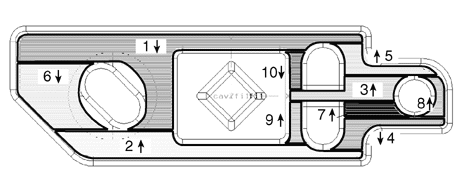
Development of CAM System for High Speed Milling
Koichi Morishige, Tetsuro Sakamoto, Yoshimi Takeuchi, Ichiro Takahashi, Kiwamu Kase and Masahiro Anzai
Proceedings of Third International Conference
on Metal Cutting and High Speed Machining,
(Metz, France, June 27-29, 2001)
Metal Cutting and High Speed Machining,
edited by D.Dudzinski et al., Kluwer Academic/Plenum Pbulishers,
pp.341-350 (2002)
In recent years, the direct carving machining is piloted,
which cuts the high hardness material directly1-4, and is made practicable
because of the improvement of the tool coating technology, the tool material,
and the tool shape etc.
Authors previously advocated the machining method characterized
by the use of zigzag path with only a small ball end mill for finishing,
and developed a super high-speed milling machine to realize the method,
which has a high-speed air spindle of 120,000 rpm and a rapid feed drive
system of 100m/min. The purpose of adopting zigzag path is to solve
the problem of the conventional machining method such as the great decrease
in feed rate due to the minutely divided NC data, and so on.
Most of CAD/CAM softwares for high-speed milling do not consider
the said problem, and there are very few research reports concerning
the cutter path generation suitable for high-speed milling.
In this study, the causes of above problems are examined on the basis of
the data of the measured cutting force etc. obtained by some fundamental
machining experiments.Next, the zigzag path and the algorithm for
generating the path are also examined to control the problems.
Finally, using the offset path generated from a commercial CAM and
the zigzag path generated by the developed CAM, the comparison experiment
is performed. As the result, the validity of the developed CAM is
actually shown.


 [Takeuchi Lab. Home Page]
[Takeuchi Lab. Home Page]
2001, by K.Morishige





 [Takeuchi Lab. Home Page]
[Takeuchi Lab. Home Page]